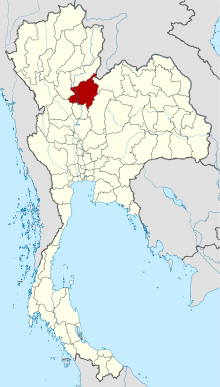This article needs additional citations for verification. (April 2021) |
Phitsanulok
พิษณุโลก | |
|---|---|
From left to right, top to bottom : Wat Phra Si Rattana Mahathat, Phu Hin Rong Kla National Park, Namtok Chat Trakan National Park, Phitsanulok City Pillar Shrine, Thung Salaeng Luang National Park, Naresuan University | |
| Nickname(s): Mueang Song Khwae (Thai: เมืองสองแคว) (City of two tributaries) | |
| Motto(s): พระพุทธชินราชงามเลิศ ถิ่นกำเนิดพระนเรศวร สองฝั่งน่านล้วนเรือนแพ หวานฉ่ำแท้กล้วยตาก ถ้ำและน้ำตกหลากตระการตา ("Beautiful Phra Phuttha Chinnarat. Hometown of King Naresuan. Raft homes of the Nan River. Truly sweet dried bananas. Amazing caves and waterfalls.") | |
 Map of Thailand highlighting Phitsanulok province | |
| Country | Thailand |
| Capital | Phitsanulok |
| Government | |
| • Governor | Thawi Sermphakdeekul (since 2024) |
| Area | |
• Total | 10,589 km2 (4,088 sq mi) |
| • Rank | Ranked 15th |
| Population (2019)[2] | |
• Total | 865,247 |
| • Rank | Ranked 28th |
| • Density | 82/km2 (210/sq mi) |
| • Rank | Ranked 60th |
| Human Achievement Index | |
| • HAI (2022) | 0.6190 "low" Ranked 67th |
| GDP | |
| • Total | baht 93 billion (US$3.2 billion) (2019) |
| Time zone | UTC+7 (ICT) |
| Postal code | 65xxx |
| Calling code | 055 |
| ISO 3166 code | TH-65 |
| Vehicle registration | พิษณุโลก |
| Founded | 11th century |
| Website | www |
Phitsanulok (Thai: พิษณุโลก, pronounced [pʰít.sā.nú.lôːk]; lit. 'Vishnu's heaven'), is a province of central Thailand.[a] It borders the provinces of Uttaradit to the north, Loei and Phetchabun to the east, Phichit to the south, Kamphaeng Phet to the southwest, and Sukhothai to the west. Its border was shared with Laos (Sainyabuli) to the northeast. Covering an area of 10,815 square kilometres (4,176 sq mi), Phitsanulok is the fifteenth-largest province in Thailand. As of 2023[update], it has a population of about 840,000, making it the eighth-most populous province in the region.
Settlement in what is now Phitsanulok began in the Stone Age, as many evidences have been found in the area indicative of the time period. Between 11th–12th century, the present-day Phitsanulok was location to ancient city-states of Thailand, such as Song Khwae, Nakhon Thai. From 13th century onward, Phitsanulok became a major city in Sukhothai and Ayutthaya Kingdom, even serving as the capital city of both. It retained strategic importance during the Thonburi and early Rattanakosin period. Following Monthon system was organized in 1897, Phitsanulok is the center of Monthon Phitsanulok, composed of various provinces in lower northern region.
With the convenience of transportation and has a long history, Phitsanulok is the center of the lower northern Thailand. It known for Wat Phra Si Rattana Mahathat, a Buddhist temple where locate famous gold-covered statue of the Buddha, Phra Phuttha Chinnarat (พระพุทธชินราช).
- ^ "ตารางที่ 2 พี้นที่ป่าไม้ แยกรายจังหวัด พ.ศ.2562" [Table 2 Forest area Separate province year 2019]. Royal Forest Department (in Thai). 2019. Retrieved 6 April 2021, information, Forest statistics Year 2019, Thailand boundary from Department of Provincial Administration in 2013
{{cite web}}: CS1 maint: postscript (link) - ^ รายงานสถิติจำนวนประชากรและบ้านประจำปี พ.ส.2562 [Statistics, population and house statistics for the year 2019]. Registration Office Department of the Interior, Ministry of the Interior. stat.bora.dopa.go.th (in Thai). 31 December 2019. Retrieved 26 February 2020.
- ^ "ข้อมูลสถิติดัชนีความก้าวหน้าของคน ปี 2565 (PDF)" [Human Achievement Index Databook year 2022 (PDF)]. Office of the National Economic and Social Development Council (NESDC) (in Thai). Retrieved 12 March 2024, page 51
{{cite web}}: CS1 maint: postscript (link) - ^ "Gross Regional and Provincial Product, 2019 Edition". <>. Office of the National Economic and Social Development Council (NESDC). July 2019. ISSN 1686-0799. Retrieved 22 January 2020.
- ^ "การแบ่งภูมิภาคทางภูมิศาสตร์". สำนักงานราชบัณฑิตยสภา.
- ^ "amazing THAILAND : แบ่งตามภูมิภาค". การท่องเที่ยวแห่งประเทศไทย.
Cite error: There are <ref group=lower-alpha> tags or {{efn}} templates on this page, but the references will not show without a {{reflist|group=lower-alpha}} template or {{notelist}} template (see the help page).







